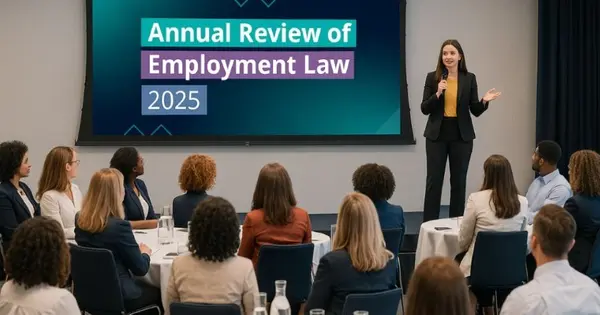
Gareth Walls is a Partner and Head of the A&L Goodbody's Employment group in Belfast. Gareth represents a number of local, national and international brands in business support, strategic workforce planning and high-profile tribunal matters. He also has significant experience advising stakeholders on complex redundancy, re-structuring and TUPE issues. Gareth is an accomplished commercial litigator with particular emphasis on procurement challenges and injunctive relief in the Employment context, as well as being a sought-after speaker on Employment issues in Northern Ireland.
There are certain essential steps that must be followed when considering making redundancies. Whilst some situations may be particularly fact sensitive, and whilst there is some degree of flexibility in the process, if you find yourself not adhering any of the following steps, you should take legal advice to ensure that you are not opening the Company up to any indefensible risk. This note focusses on redundancies that are not collective redundancy situations.
STEP 1: Is there a genuine redundancy situation?
Broadly speaking redundancy situations fall into three categories:
- Business closure (ie closure of the business altogether).
- Workplace closure (ie closure of one of several sites, or relocation to a new site).
- Diminished requirements of the business for employees to do work of a particular kind.
STEP 2: Establish how many redundancies are being proposed.
- If there are 20 or more redundancies being proposed in a 90 day period then collective consultation obligations arise. The Company must notify the Department for Employment and Learning. We recommend that you take bespoke legal advice if collective redundancies are being contemplated.
- If fewer than 20 redundancies are being proposed, the Company must still follow fair procedures in relation to each employee at risk of redundancy.
STEP 3: Consider the appropriate pool and selection criteria (and keep notes of your considerations).
- Ensure that you think broadly when deciding upon the pool(s).
- Ensure that selection criteria are objective.
STEP 4: List any alternative vacancies.
- The Company should prepare a list of alternative vacancies that are available across the Company or, where appropriate, Group.
STEP 5: Write to the employees at risk of redundancy
- The employees should be invited to a meeting to discuss the proposed redundancies. Explain that there will be a meeting of all employees together, followed by individual consultation meetings.
- The letter should include a summary of the reasons why the redundancies may be necessary and an overview explanation of the proposed consultation process.
STEP 6: First Group Meeting (ensure this is minuted)
- Meet with all the employees potentially at risk. Explain:
* the reason for the proposed redundancies.
* that the Company is endeavouring to find ways to avoid the redundancies.
* the consultation that will follow. M-22237276-1 2
* the pools and proposed selection criteria.
* that the company would like to invite suggestions from the employees as to how redundancies can be avoided.
* the right to take time off to seek alternative employment.
- Follow the meeting up in writing and enclose copies of the proposed selection criteria.
STEP 7: Scoring
- Score each affected employee using the objective selection criteria.
- Scoring should be carried out by at least 2 line managers who work closely with the employee, where possible.
STEP 8: Write to the affected employees
- Explain that they have been provisionally selected for redundancy.
- Inform them that they may be accompanied by a trade union representative or colleague.
- Explain again the reason why the redundancies may be necessary and summarise the scoring result that has led to them being at risk.
- Explain that whilst no decision has been taken in this regard, there is a risk that their employment may be terminated (this is essential in order to comply with the statutory regulations on dismissal).
- Enclose an up to date vacancy list.
- Ask them to attend at a meeting to discuss the potential redundancy.
STEP 9: First Individual Meeting (ensure this is minuted)
- Consult with the employee about the redundancy proposal and any suggestions that the employee may have to avoid the redundancy situation.
- Discuss the employee's scores and the redundancy terms.
- Caselaw suggests that employees should be provided with the "breakpoint", namely the score that the employee would have needed to avoid selection. Ultimately the employee will need to be provided with sufficient information that allows them to challenge the assessment process.
- Discuss potential alternative employment options, if any.
STEP 10: Follow up (take notes of your considerations)
- Follow up on any matters discussed during the first individual meeting.
STEP 11: Second Individual Meeting (ensure this is minuted)
- Assuming that there is nothing from the first meeting that changes the Company's stance, invite the employee to a further meeting. Inform the employee that they may be accompanied by a trade union representative or colleague.
- At the meeting, confirm that the employee has been selected for redundancy. M-22237276-1 3
- Discuss the redundancy package.
STEP 12: Dismissal letter
- Write to the employee confirming the decision to dismiss them as redundant. Confirm the termination date and payments to be made to the employee.
- Confirm that the employee has the right to appeal the decision.
STEP 13: Appeal (ensure this is minuted)
- If the employee raises an appeal, invite them to a meeting to hear the appeal. The meeting should be chaired by someone more senior to the person who took the decision to dismiss.
- Inform the employee that they have the right to be accompanied by a trade union representative or colleague.
- Confirm the appeal decision to the employee in writing.
Continue reading
We help hundreds of people like you understand how the latest changes in employment law impact your business.
Please log in to view the full article.
What you'll get:
- Help understand the ramifications of each important case from NI, GB and Europe
- Ensure your organisation's policies and procedures are fully compliant with NI law
- 24/7 access to all the content in the Legal Island Vault for research case law and HR issues
- Receive free preliminary advice on workplace issues from the employment team
Already a subscriber? Log in now or start a free trial

